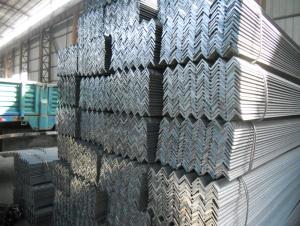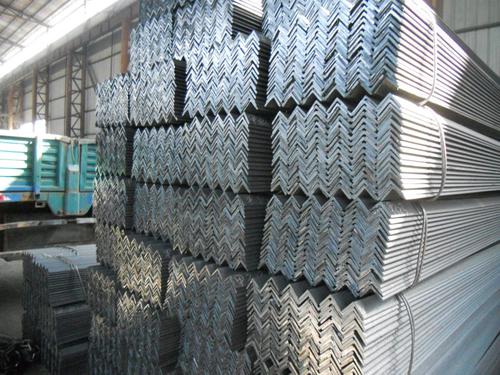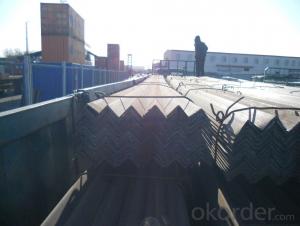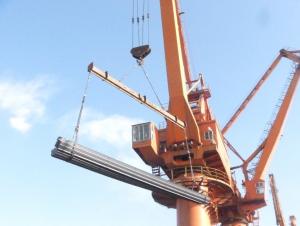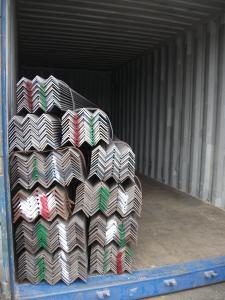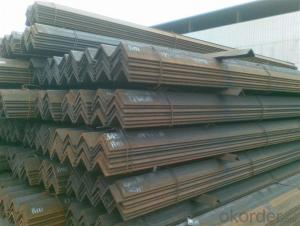GB Standard Steel Angle Bar
- Loading Port:
- China Main Port
- Payment Terms:
- TT OR LC
- Min Order Qty:
- -
- Supply Capability:
- -
OKorder Service Pledge
OKorder Financial Service
You Might Also Like
Specifications of Angle Steel
1. Invoicing on theoretical weight or actual weight as customer request.
2. Length: 6m, 9m, 12m.
3. Sizes:
| Size(mm) | Mass(Kg/m) | Size(mm) | Mass(Kg/m) |
| 75*75*6 | 6.905 | 80*80*6 | 7.376 |
| 75*75*7 | 7.976 | 80*80*7 | 8.525 |
| 75*75*8 | 9.03 | 80*80*8 | 9.658 |
Payment terms:
1).100% irrevocable L/C at sight.
2).30% T/T prepaid and the balance against the copy of B/L.
3).30% T/T prepaid and the balance against L/C.
Material details:
Alloy No | Grade | Element (%) | | ||||
C | Mn | S | P | Si | | ||
| | |||||||
|
|
|
|
|
|
| |
Q235 | B | 0.12—0.20 | 0.3—0.7 | ≤0.045 | ≤0.045 | ≤0.3 | |
|
|
|
|
|
|
| |
Alloy No | Grade | Yielding strength point( Mpa) | | ||||
Thickness (mm) | | ||||||
≤16 | >16--40 | >40--60 | >60--100 | | |||
≥ | | ||||||
|
|
|
|
|
| | |
Q235 | B | 235 | 225 | 215 | 205 | | |
Alloy No | Grade | Tensile strength (Mpa) | Elongation after fracture (%) | | |||
Thickness (mm) | | ||||||
| ≤16 | >16--40 | >40--60 | >60--100 | | ||
≥ | | ||||||
|
|
|
|
|
|
| |
Q235 | B | 375--500 | 26 | 25 | 24 | 23 | |
*If you would like to get our price, please inform us the size, standard/material and quantity. Thank you very much for your attention.
- Q: Can steel angles be used for supports in bridges?
- Steel angles can indeed be utilized as supports in bridges. These angles are frequently employed in bridge construction due to their capacity to provide both strength and stability. They serve as vertical supports, known as piers or columns, as well as horizontal supports, referred to as beams or girders. The usage of steel angles in bridge construction offers numerous benefits. These include their exceptional strength-to-weight ratio and their ability to endure substantial loads and vibrations. Moreover, steel angles are highly adaptable and can be easily fabricated and connected, resulting in efficient and cost-effective bridge construction. All in all, due to their enduring nature, dependability, and efficiency in supporting the weight and load of a bridge structure, steel angles are widely favored as a choice for bridge supports.
- Q: What are the standard dimensions of steel angles?
- The standard dimensions of steel angles vary depending on the specific type and grade of steel used. However, common standard dimensions for steel angles include leg lengths ranging from 1/2 inch to 8 inches and thicknesses ranging from 1/8 inch to 1 inch.
- Q: What does angle 5 mean?
- The specifications are expressed in millimeters of edge width * edge width * edge thickness. Such as "/ 30 x 30 x 3", that is 30 mm width equal angle, edge thickness of 3 mm. Also available models that model is the number of centimeters wide, such as angle 3#. The model does not mean the size of the different edges and sizes of the same model. Therefore, the width, the edge and the thickness of the angle iron should be filled out in the contract and other documents, so as not to be indicated by the model alone. Standard Specification for hot-rolled equal angle iron is 2#-20#.
- Q: How do steel angles compare to wooden beams?
- Steel angles and wooden beams possess distinct characteristics and abilities that render them suitable for diverse applications. Steel angles, being comprised of steel, demonstrate exceptional strength and longevity. They exhibit remarkable tensile strength and resist bending and warping even when subjected to substantial loads. This renders them an excellent choice for providing structural support in constructions such as buildings, bridges, and other similar projects. Moreover, steel angles possess the advantage of being non-combustible, thereby enhancing fire safety. Conversely, wooden beams offer their own set of advantages. As a natural material, wood is readily accessible and renewable, making it a more environmentally conscious option when compared to steel. Additionally, wooden beams possess an inherent aesthetic appeal, particularly in traditional or rustic designs. They can be effortlessly customized and shaped, enabling the creation of intricate and imaginative designs. Nevertheless, wooden beams do have certain limitations with regards to strength and durability. They do not exhibit the same level of robustness as steel angles and are susceptible to bending, warping, and rotting over time. Additionally, wood is combustible, which can pose safety concerns. In conclusion, both steel angles and wooden beams possess their own unique strengths and weaknesses. Steel angles excel in projects necessitating high strength and durability, while wooden beams offer a more natural and visually appealing option. Ultimately, the choice between the two depends on specific project requirements, budgetary considerations, and personal preferences.
- Q: Are there any industry standards or certifications for steel angles?
- Yes, there are industry standards and certifications for steel angles. The most widely recognized standard for steel angles is the American Society for Testing and Materials (ASTM) standard. The ASTM A36 specification is commonly used for structural steel angles and provides specific requirements for chemical composition, mechanical properties, and dimensional tolerances. In addition to ASTM, other organizations such as the American Institute of Steel Construction (AISC) and the Steel Joist Institute (SJI) provide guidelines and standards for steel angles used in construction and structural engineering applications. These standards ensure that steel angles meet specific requirements for quality, strength, and performance. Furthermore, certifications such as ISO 9001:2015 and ISO 14001:2015 are widely recognized in the steel industry, indicating that a manufacturer has implemented a quality management system and meets environmental management standards. It is important for manufacturers, suppliers, and construction professionals to adhere to these industry standards and certifications to ensure the reliability and safety of steel angles in various applications.
- Q: What are the different types of steel angles used in scaffolding?
- Scaffolding commonly utilizes various types of steel angles, each serving a specific purpose. These include: 1. Equal Angles: These steel angles possess equal sides and are frequently employed as a stable base or support within scaffolding structures. They contribute to the overall sturdiness and strength of the scaffolding system. 2. Unequal Angles: As the name implies, these steel angles have unequal sides. They prove useful when different lengths are required on each side, such as for creating diagonal bracing or connecting different parts of the scaffolding system. 3. L-Shaped Angles: This type of steel angle forms a 90-degree angle and is commonly utilized for constructing corners or connecting perpendicular scaffolding components. It provides essential structural support and stability to the scaffolding structure. 4. T-Shaped Angles: These steel angles take on a T-shape and are employed to connect two perpendicular scaffolding components. They offer stability and support to the scaffolding system. 5. Channel Angles: Featuring a U-shaped channel, this type of steel angle is frequently used as a top or bottom cross member in scaffolding structures. Its design facilitates easy attachment of scaffolding components, while bolstering the overall strength of the scaffolding system. These various steel angles present scaffolding structures with versatility and robustness, enabling diverse configurations and designs to suit the specific needs of each project.
- Q: What is the maximum allowable torsional stress for a steel angle?
- The maximum allowable torsional stress for a steel angle depends on various factors such as the type of steel, its dimensions, and the specific application. Therefore, it is not possible to provide a specific value without more information.
- Q: How do you install steel angles?
- In order to install steel angles, there are several steps that need to be followed. Begin by determining the suitable location and angle for the steel angle. Use a tape measure and a level to ensure proper alignment. Proceed by marking the spots where the steel angle will be installed. Precise markings can be made on the wall or floor using a pencil or chalk. Once the markings are finished, create pilot holes at the marked locations using a drill. The drill bit size should match the size of the screws or anchors you plan to use. It is important to drill into the studs or solid support structure behind the wall to ensure a secure installation. After drilling the pilot holes, align the steel angle with the markings on the wall or floor. Make use of a level to guarantee it is perfectly straight. Once aligned, insert screws or anchors through the holes in the steel angle and into the pilot holes. Using a screwdriver or drill, tighten the screws or anchors until the steel angle is firmly attached to the wall or floor. Repeat this process for any additional steel angles that need to be installed. Finally, check the installation to verify that the steel angles are level and securely attached. If necessary, make any adjustments to the screws or anchors to achieve proper installation. Always remember to follow the instructions provided by the manufacturer and take appropriate safety precautions when installing steel angles. If you are uncertain about any step of the installation process, it is advisable to seek professional assistance.
- Q: Can steel angles be used in the construction of railway bridges?
- Certainly! Railway bridges can indeed incorporate steel angles into their construction. Steel angles possess great versatility as structural elements and can serve multiple purposes, including bridge construction. They are frequently employed in the manufacturing of bridge girders, braces, and supports. Thanks to their exceptional strength and ability to bear heavy loads, steel angles are ideal for railway bridges that demand robust structural integrity and longevity. Moreover, the ease with which steel angles can be welded, bolted, or riveted together facilitates efficient and cost-effective construction methods. Ultimately, steel angles represent a viable and frequently utilized component in the construction of railway bridges.
- Q: Can steel angles be used for staircases?
- Yes, steel angles can be used for staircases. Steel angles are commonly used as structural supports in construction, including for staircases. They provide strength and stability to the staircase structure and can be designed to meet specific load-bearing requirements.
Send your message to us
GB Standard Steel Angle Bar
- Loading Port:
- China Main Port
- Payment Terms:
- TT OR LC
- Min Order Qty:
- -
- Supply Capability:
- -
OKorder Service Pledge
OKorder Financial Service
Similar products
Hot products
Hot Searches
Related keywords
